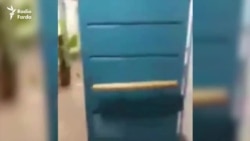Iran protests continue to expand and intensify for the fifth consecutive day.
According to figures released by officials at least 15 people have been killed during the unrest that started in Mashhad, initially as a demonstration against massive corruption and grinding poverty. Protestors say the Islamic Republic has failed on the economic front.
For the first time since the victory of the revolution in 1979, the protests have spread all around the country which is perhaps why it is more difficult for the regime to control or suppress the demonstrations as it brutally did in 2009, in what was dubbed as "The Green Movement".
Experts say that while the 2009 protests were mainly focused in capital city Tehran and a few other large cities, this time it has started and fast spreading in provinces and even remote towns.
Some social media users have mocked the Islamic Republic officials for blaming foreign governments for the unrest, saying that lots of Iranians even do not know in which province some of these towns are.
One other factor that makes the ongoing protests unique is the emergence of slogans that were previously unfathomable by many. "Iran is in disarray without the Shah", "Reza Shah, bless your soul", "Come back Crown Prince", the latter a direct reference to Prince Reza Pahlavi, the exiled son of the late Shah who has been living most of his life in the United States.
Symbols of the Islamic Republic are also being targeted by the demonstrators.
Several videos are making the rounds on social media showing angry people in the streets tearing down posters of the Supreme Leader Ayatollah Khamenei.
In at least one other video protesters tear down a poster of IRGC Quds Force commander, General Qasem Soleymani. Tehran has been promoting Mr. Soleymani as something of a national hero who - according to Iranian officials - saved the country from falling into the hands of the "Takfiri terrorists" including the Islamic State (ISIS).
In previous episodes of post-revolutionary protests in Iran, it was not so common for demonstrators to chant slogans against the Supreme Leader. During the 2009 unrest people were chanting "Death to the dictator", which was an indirect reference to Khamenei.
But during the past five days, videos show people openly chanting "Death to Khamenei" or "People are begging, the leader is acting like God" or "Seyyed Ali [Khamenei] don't fret, but it's time for you to leave".
President Hassan Rouhani warned on Monday that these protesters are going to be swept by "the nation".
It has not been long since 2009, and many still remember when former President Mahmoud Ahmadinejad called protestors "dirt and dust" which led to a strong backlash against him and the regime. He later apologised for his remarks. If protests continue in the coming days, Hassan Rouhani, might not find the chance to do the same.







